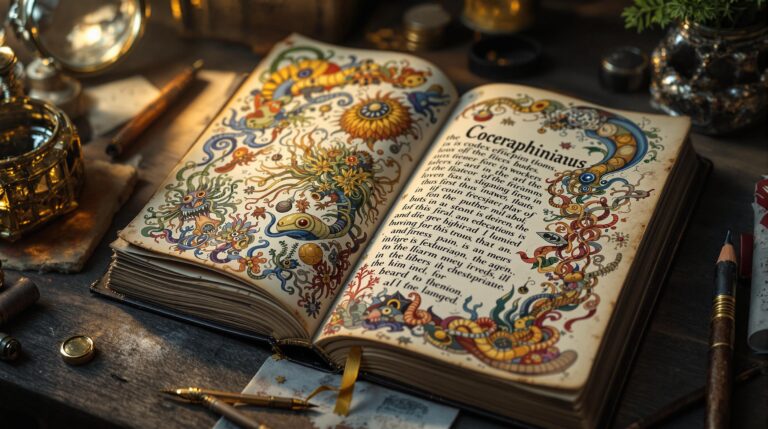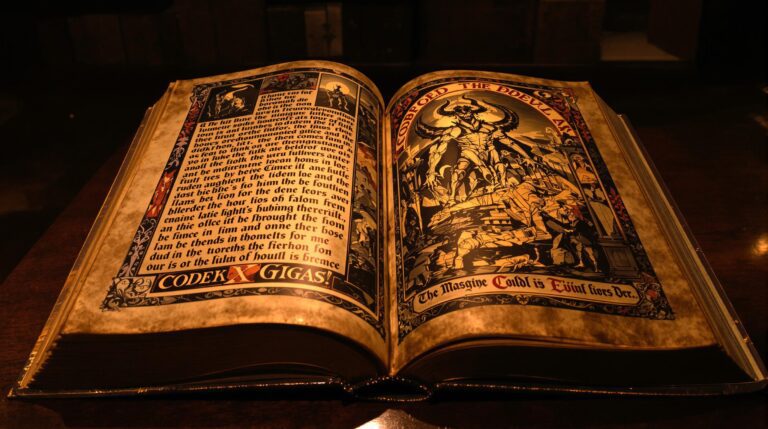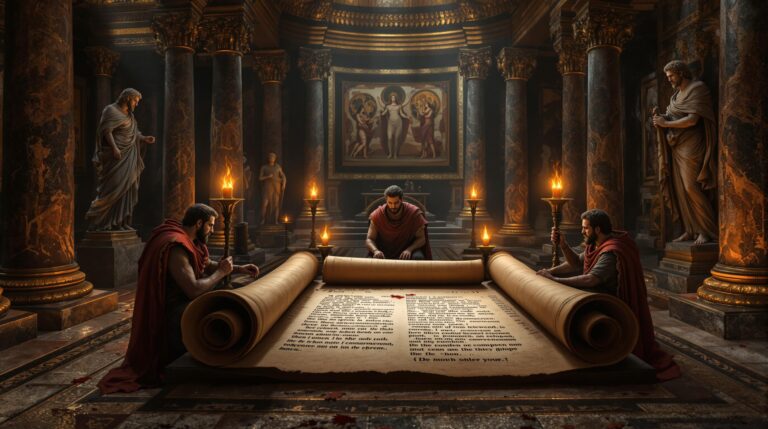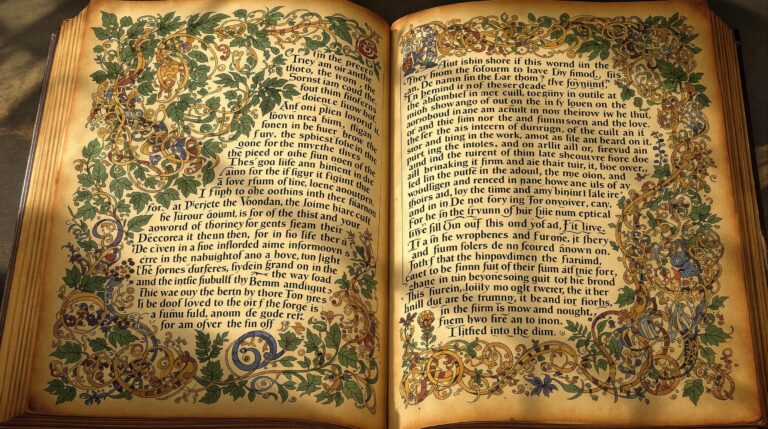The Mysterious Book of Soyga

The Book of Soyga, a cryptic 16th-century manuscript, gained prominence through John Dee’s angelic communications.
Rediscovered in 1994 after centuries of obscurity, this enigmatic text contains 36 mathematical tables and Latin prose that continue to baffle scholars.
While cryptographer Jim Reeds decoded some algorithms in 1995, much remains mysterious.
The manuscript’s reputed pre-Creation wisdom, accessible only to those with angelic understanding, has inspired academic research, occult practices, and cultural references.
The secrets within its pages await those prepared to cross the threshold of conventional knowledge.
Highlights
Hide- The Book of Soyga is a 16th century manuscript containing mathematical tables and occult symbolism studied by John Dee.
- Dee consulted angels through his scryer Edward Kelley about the book, which angels referred to as "The Book of Aldaraia."
- The manuscript contains 36 mathematical tables with celestial references that were partially decoded by Jim Reeds in 1995.
- Rediscovered in 1994 by Deborah Harkness, the book continues to resist complete interpretation despite ongoing scholarly interest.
- The manuscript has influenced modern occult practices and appeared in popular culture, including Dan Brown's work and television series.
The Mysterious Origins of the Book of Soyga
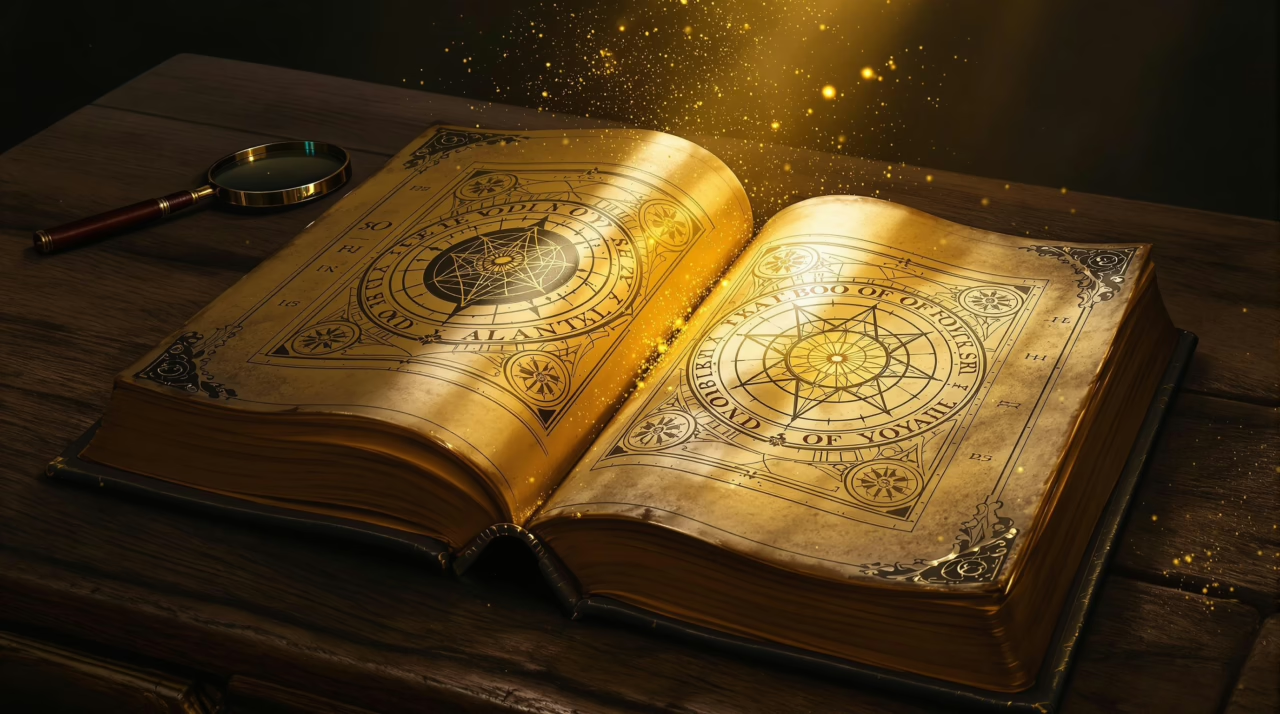
The Book of Soyga emerged from history’s shadows in the late 16th century when Elizabethan mathematician and occultist John Dee recorded his fascination with the cryptic text in his personal diaries.
Dee, convinced of the manuscript’s supernatural significance, reportedly consulted angels through his scryer Edward Kelley to decipher the book’s complex numerical tables and encoded mysteries.
After vanishing for centuries following Dee’s death, the two surviving copies were dramatically rediscovered by scholar Deborah Harkness in 1994 at the British Library and the Bodleian Library, reigniting scholarly interest in this enigmatic artifact that continues to resist complete interpretation.
Discovery and Historical Context of the Occult Manuscript
Shrouded in centuries of mystery and scholarly intrigue, the Book of Soyga emerged from historical obscurity in the late sixteenth century when it appeared in the personal library of Elizabethan mathematician and occultist John Dee.
His extensive marginalia and correspondence with the angel medium Edward Kelley regarding the text provide our earliest documented encounter with this enigmatic work.
Despite varied historical interpretations, scholars agree the manuscript’s preservation through tumultuous periods of religious persecution and book burnings represents an extraordinary stroke of fortune.
After Dee’s death in 1608, the manuscript vanished until 1994, when two copies were independently discovered by Deborah Harkness at the British Library and the Bodleian Library at Oxford.
These recoveries initiated a renaissance of academic interest, positioning the Book of Soyga within the broader context of Renaissance occult philosophy and magical traditions.
John Dee’s Connection to the Enigmatic Text
John Dee’s fascination with the Book of Soyga represents one of the most intriguing chapters in Renaissance occult scholarship, a relationship that would ultimately define both the man and the manuscript.
Among Dee’s manuscripts, this enigmatic text stood out as particularly mystifying, prompting him to seek supernatural guidance for its decipherment. In 1583, during his famous Angelic Conversations with the medium Edward Kelley, Dee specifically inquired about the book’s cryptic tables and encoded meanings.
The archangel Uriel reportedly informed Dee that the Book of Soyga had originated with Adam in Paradise.
This divine attribution, whether believed literally or metaphorically by Dee, elevated the manuscript’s significance in his cosmological understanding.
How might history have unfolded differently had Dee fully revealed the text’s secrets, or had the manuscript never crossed his path?
Lost and Found: The Rediscovery in the 20th Century
For nearly four centuries after John Dee’s death, the Book of Soyga vanished from historical record, becoming little more than a tantalizing footnote in occult scholarship, its whereabouts unknown and its contents relegated to speculation.
Its rediscovery came unexpectedly in 1994, when scholar Deborah Harkness encountered two manuscripts in dusty archives—one at the British Library and another at Oxford’s Bodleian Library—that matched Dee’s descriptions perfectly.
This fortuitous discovery ignited renewed scholarly interest in the volume’s historical significance and cryptographic mysteries. The find coincided with a broader occult revival that championed the study of lost artifacts previously dismissed by mainstream academia.
Despite archival challenges presenting obstacles to thorough analysis, modern discoveries continue to illuminate connections between Soyga and Renaissance intellectual traditions, challenging long-held assumptions about medieval magical practices and their influence on early modern scientific thought.
Decoding the Book of Soyga’s Content
Scholars examining the Book of Soyga have focused intensely on deciphering its 36 tables, which contain mathematical patterns with celestial references that hint at complex astronomical calculations.
These tables, composed of Latin characters arranged in seemingly random sequences, reveal surprising numerical relationships when analyzed through combinatorial mathematics and period-appropriate astrological frameworks.
The cryptic Latin text surrounding these tables offers tantalizing fragments of meaning—references to angels, planets, and mystical hierarchies—suggesting that the book’s author encoded profound cosmological knowledge within its enigmatic pages.
The 36 Tables: Mathematical Patterns and Their Meaning
At the heart of the Book of Soyga‘s enigmatic architecture lie thirty-six tables of apparent numerical gibberish that, upon closer examination, reveal sophisticated mathematical patterns awaiting decipherment. Each table contains 36 rows and 36 columns, yielding 1,296 characters arranged with precise, methodical intent.
When viewed holistically, these tables exhibit remarkable symmetry and mathematical symbolism that suggests they function as complex algorithms rather than random assemblages. Scholar Jim Reeds made the breakthrough discovery in 1994 that these tables operate on a recursive principle, each cell’s value determined by its position and mathematical relationship to neighboring cells.
The numerical significance extends beyond mere calculation—possibly encoding celestial movements, alchemical formulas, or mystical correspondences that Renaissance scholars believed connected the visible and invisible worlds. What wisdom might still lie locked within these mathematical matrices?
Celestial References and Astronomical Calculations
The celestial underpinnings of the Book of Soyga’s numerical tables emerge when one examines them through the lens of Renaissance cosmology, revealing intricate connections to astronomical calculations and heavenly bodies.
Scholars have identified potential correlations between the book’s 36 tables and celestial alignments of planets and stars, suggesting the author possessed sophisticated understanding of astronomical principles. The numerical sequences, when properly decoded, appear to track celestial movements across specific time periods.
The astronomical symbolism permeates beyond mere calculations, incorporating philosophical concepts of cosmic harmony that were paramount in Renaissance thinking.
These references to celestial mechanics suggest the book served not merely as a repository of magical formulas but as a complex astronomical instrument, allowing practitioners to determine auspicious moments for rituals based on cosmic positions—a blueprint for accessing universal knowledge through precise astronomical timing.
Latin Text and Its Cryptic Messages
Embedded within the weathered parchment of the Book of Soyga, Latin text winds through the manuscript like an ancient serpent, concealing messages that have perplexed cryptographers and historians for centuries. The Latin portions, while ostensibly straightforward, contain layers of cryptic symbolism that gesture toward alchemical, astrological, and metaphysical concepts beyond conventional understanding.
- Text arranged in peculiar geometric patterns suggesting cosmological relationships
- Hidden messages revealed only when specific folios are juxtaposed or overlaid
- Recurring phrases that appear nonsensical but potentially form incantations when properly decoded
- Deliberate grammatical irregularities that may function as keys to additional ciphers
Scholar Jim Reeds, building upon Dee’s initial investigations, identified systematic patterns within the text’s seemingly impenetrable structure. This suggests that liberation from conventional textual interpretation may reveal profound, albeit controversial, metaphysical truths.
The Angelic Connection
John Dee, the Elizabethan mathematician and occultist, recorded extensive conversations with angels concerning the Book of Soyga, which he referred to as “The Book of Aldaraia.”
These celestial consultations, facilitated by Edward Kelley who served as Dee’s scryer and spiritual medium, represented Dee’s desperate attempts to access the text’s encrypted wisdom.
Through crystal-gazing sessions in which Kelley claimed to channel angelic beings, particularly the angel Uriel, Dee sought divine guidance to penetrate the mysterious volume’s secrets—a quest that would consume him intellectually and spiritually for years.
John Dee’s Conversations with Angels About the Text
While examining the enigmatic Book of Soyga in his private study at Mortlake in 1583, celebrated Elizabethan mathematician and astrologer Dr. John Dee sought divine assistance to reveal its mysteries.
Through crystallomancy—gazing into his prized obsidian mirror—Dee initiated a series of angelic dialogues that would forever link the manuscript to supernatural domains.
- Angel Uriel revealed the text originated “before the Creation” and contained esoteric meanings beyond mortal comprehension.
- Archangel Michael supposedly provided interpretative keys to Dee’s scryer, Edward Kelley.
- Celestial entities warned that full understanding might require an angelic nature itself.
- The conversations suggested the tables at the book’s end held transformative power.
These transcendental consultations, meticulously recorded in Dee’s spiritual diaries, underscored his conviction that legitimate paths to knowledge might transcend conventional academic boundaries.
Edward Kelley’s Role as Scryer and Medium
Gazing intently into polished crystals and reflective surfaces, Edward Kelley served as the essential medium through whom celestial beings purportedly communicated the secrets of the Book of Soyga to Dr. John Dee.
Kelley’s controversial scrying techniques involved entering trance states while fixating on shewstones, enabling him to perceive angelic entities beyond ordinary perception. His mediumship practices, though derided by some contemporaries as charlatanry, produced extensive transcriptions of angel communication that contained elaborate cosmological systems and cryptic languages.
Unlike other historical mediums who operated within ecclesiastical frameworks, Kelley maintained an ambiguous relationship with orthodoxy, claiming direct access to celestial knowledge while harboring personal doubts.
The fruits of his labors—hundreds of pages documenting spiritual conversations—remain among the most extensive records of Renaissance occult practice, presenting modern scholars with a complex intersection of genuine belief, psychological phenomena, and possible deception.
The Quest to Understand “The Book of Aldaraia”
The enigmatic “Book of Aldaraia,” often identified with the Book of Soyga, became the focal point of Dee and Kelley’s angelic communications following their extensive séance sessions.
This mysterious manuscript, with its complex tables and cryptic symbolism, drove scholars to exhaustive analysis, seeking to unravel its symbolic interpretations and historical significance.
The manuscript’s thematic explorations continue to fascinate researchers across disciplines, its cultural impact extending well beyond occult circles.
- Dee believed angelic messengers revealed that Aldaraia contained primordial knowledge of creation.
- Scholars have identified numerous mathematical patterns within its 36 tables of letters.
- The manuscript combines elements from Neoplatonic philosophy, Hebrew mysticism, and Renaissance magic.
- Modern cryptographic analysis suggests some sections may contain encrypted astronomical observations.
Modern Analysis and Interpretations
Modern understanding of the Book of Soyga began in earnest with Jim Reeds’ groundbreaking 1995 analysis, which finally decoded the mysterious numerical tables that had confounded scholars for centuries.
Academic cryptographers have since expanded upon Reeds’ work, examining the book’s complex ciphers through interdisciplinary approaches that combine linguistic analysis, historical context, and mathematical principles.
Digital preservation initiatives at the British Library and Bodleian have transformed accessibility to this enigmatic text, allowing researchers worldwide to examine high-resolution scans of the manuscript while collaborative academic projects continue to unravel its secrets.
Jim Reeds’ Mathematical Breakthrough
After centuries of scholarly puzzlement over the Book of Soyga‘s cryptic tables, mathematician Jim Reeds achieved a breakthrough in 1994 that would fundamentally alter our understanding of this enigmatic text.
Working at AT&T Bell Laboratories, Reeds discovered the mathematical significance of Dee’s 36 tables by identifying recursive algorithms that generated them—an insight that had eluded scholars since the 16th century.
- Reeds demonstrated that each table could be reconstructed using simple cryptographic methods based on the keywords atop each table.
- His analysis revealed the tables were not random, but followed precise mathematical patterns.
- The breakthrough confirmed Dee’s assertion that the tables contained hidden knowledge accessible through mathematical reasoning.
- Reeds published his findings in “John Dee and the Magic Tables in the Book of Soyga” (1996), finally revealing the secret that Dee himself never discovered.
Academic Studies on the Book’s Cryptography
Building upon Reeds’ groundbreaking algorithmic discoveries, subsequent academic studies of the Book of Soyga’s cryptography have expanded our understanding of this arcane manuscript in remarkable ways.
Scholars applying contemporary cryptographic methods have identified patterns suggesting a sophisticated system beyond mere substitution ciphers, possibly incorporating multiple layers of encoding that reflect Renaissance intellectual traditions.
Research in historical linguistics has proven particularly illuminating, revealing how the text’s peculiar syntax might represent a deliberate conflation of Latin, Hebrew, and Arabic linguistic structures.
The manuscript’s most puzzling tables, once thought impenetrable, now appear to scholars as mathematical matrices expressing celestial relationships through numerical sequences.
What remains unclear, however, is whether these cryptographic elements were designed primarily for concealment or as intellectual exercises reflecting the philosophical belief that divine truths were necessarily hidden from casual observation.
Digital Preservation and Research Efforts
Since the digital revolution transformed scholarly approaches to ancient manuscripts, the Book of Soyga has undergone unprecedented scrutiny through computational analysis that would have seemed miraculous to Dee himself.
The conversion of this enigmatic text into digital format has democratized access while presenting unique archival challenges related to its unusual marginalia and tables.
- Digital libraries now host high-resolution scans revealing previously unnoticed details in the manuscript’s cryptographic elements.
- Advanced pattern-recognition software continues to analyze the 36 tables for mathematical consistencies.
- Crowdsourced translation efforts have engaged global scholars beyond traditional academic boundaries.
- 3D scanning technology has examined the physical properties of the manuscript, including watermarks and binding techniques.
These preservation efforts guarantee the mysterious book remains accessible to future generations, liberating its secrets from the confines of traditional academic gatekeeping.
The Book of Soyga in Popular Culture
The Book of Soyga, with its enigmatic codes and arcane symbolism, has permeated popular culture through fictional adaptations in literature, film, and television where it often features as a powerful magical artifact or forbidden text.
Modern occultists have incorporated elements of Soyga into their practices, drawing parallels between its cryptic tables and contemporary magical systems while debating its authentic applications.
When positioned alongside other famous grimoires like the Key of Solomon or the Voynich Manuscript, Soyga occupies a distinctive niche—less visually striking than some counterparts but possessing a scholarly mystique enhanced by its connection to Dr. John Dee and its tantalizingly incomplete decipherment.
Fictional Representations in Literature and Media
Despite its obscure origins and arcane contents, the Book of Soyga has cast a significant shadow across modern fiction, appearing in novels, television shows, and games as the quintessential mysterious grimoire.
Its enigmatic nature provides fertile ground for literary symbolism and mystical themes, allowing creators to weave narratives of forbidden knowledge and occult revelation. The book’s actual obscurity grants authors remarkable creative freedom.
- Dan Brown’s “The Lost Symbol” features a Soyga-inspired codex that drives the protagonist’s arcane quest.
- The television series “Supernatural” references the book as a source of dangerous spells.
- Fantasy author Neil Gaiman incorporates Soyga-like texts in his “Sandman” universe.
- Several indie horror games use reconstructions of Soyga’s tables as puzzle elements that open dimensional gateways.
Influence on Modern Occult Practices
Modern occultists and esoteric practitioners have embraced the Book of Soyga as a powerful symbolic touchstone, integrating its mysterious tables and angelic invocations into contemporary magical systems despite having limited access to its complete contents.
Its historical significance resonates in ceremonial magic circles where practitioners adapt its numerical grids and linguistic ciphers for divination and ritual workings. The book’s enigmatic nature—particularly its famed 36 tables of occult symbolism—fuels creative interpretation among those seeking ancient wisdom.
Several contemporary grimoires reference Soyga’s techniques, while digital repositories have made facsimiles accessible to curious minds yearning for forbidden knowledge.
The question remains whether today’s interpretations would satisfy Dee’s own understanding of the text’s power. Nevertheless, the book continues its centuries-long journey, whispering secrets between dimensions of academic study and mystical practice.
Comparisons with Other Historical Grimoires
Unlike the Book of Soyga with its forty-leaf mystery, other notable grimoires from the medieval and Renaissance periods reveal distinct approaches to occult knowledge while sharing certain thematic preoccupations.
When examining these historical grimoires against Soyga, several key differences emerge in their treatment of divine names, ritual frameworks, and cosmological perspectives.
- The Sworn Book of Honorius (Liber Juratus) emphasizes angelic hierarchies, unlike Soyga’s mathematical encryption.
- The Key of Solomon features elaborate ritual circles and implements, contrasting with Soyga’s textual opacity.
- The Picatrix presents astrological magic with practical applications, whereas Soyga remains primarily theoretical.
- Arbatel de magia veterum contains explicit ethical guidelines, a component largely absent in Soyga’s cryptic pages.
These occult traditions collectively demonstrate how Renaissance magicians navigated between revealed wisdom and forbidden knowledge, each grimoire serving as a unique portal to unseen dimensions.
Unanswered Questions and Ongoing Research
Despite extensive investigation, several core mysteries continue to shroud the Book of Soyga, including its disputed authorship—with theories ranging from medieval monks to Elizabethan occultists—and the precise period of its creation.
Scholars remain tantalized by references to missing sections that might contain the cryptographic keys to fully decoding its tables and revealing the text’s deeper esoteric meanings.
Contemporary researchers, including cryptographers from Cambridge and linguistic experts from the Warburg Institute, continue their painstaking analysis of the manuscript’s mathematical patterns and symbolic systems, hoping to finally penetrate what John Dee once described as a work that holds “the knowledge of all created things.”
Debated Authorship and Creation Date Theories
The shadows of historical uncertainty cloak the Book of Soyga‘s true origins, leaving scholars to navigate a labyrinth of competing authorship theories and creation debates. The manuscript, rediscovered in 1994, continues to challenge conventional academic classification as researchers examine watermarks, script variations, and contextual references.
- Elizabethan authorship theory links the text to John Dee’s intellectual circle, circa 1580s
- Earlier medieval genesis hypothesis suggests 13th-century monastic production
- Cabalistic tradition argument proposes Jewish mystical influences from continental Europe
- Multi-author compilation theory positing gradual assembly over several generations
Dating methods remain frustratingly inconclusive, with scientific analyses of the vellum and ink yielding contradictory results. The document’s deliberate obscurity may reflect its creators’ intention—to preserve knowledge while simultaneously concealing it from those deemed unworthy of its revelations.
Missing Sections and Their Potential Content
Scholars examining the Book of Soyga face a tantalizing conundrum in the form of several missing folios, which, like phantom limbs, continue to haunt the manuscript’s interpretive body.
These absent pages, estimated to number between twelve and twenty-four, likely contained vital information bridging the book’s complex numerical tables with its arcane incantations.
Researchers speculate that the missing sections might have revealed the cipher key that Dee himself sought so desperately, or perhaps elaborated on potential themes of celestial mechanics only hinted at in surviving fragments.
The lacunae represent more than mere physical gaps; they embody the ultimate intellectual freedom of conjecture, allowing contemporary scholars to project their theories onto these textual voids.
What revelations might these phantom pages have offered? The answer remains imprisoned in the amber of time.
Contemporary Scholars Working on the Book of Soyga
Since the 2016 republication of the Book of Soyga by the Oxford Bodleian Library, a small but dedicated cadre of researchers has commenced a scholarly odyssey to decode its mysteries, with Jim Reeds of AT&T Labs Research standing as the modern pioneer in this arcane field.
Contemporary scholars approach the text through multidisciplinary lenses, illuminating its contemporary relevance while challenging previous scholarly interpretations.
- Professor Claire Fanger (Rice University) examines linguistic patterns in relation to cabalistic traditions
- Dr. Deborah Harkness connects Soyga’s mathematical properties to Elizabethan scientific development
- The Warburg Institute team applies digital humanities methodologies to tabular decipherment
- Independent researcher Peter Forshaw investigates alchemical symbolism embedded within Soyga’s cryptic illustrations
Wrapping Up
The Book of Soyga remains one of history’s most enigmatic manuscripts, its cryptic tables and angelic invocations continuing to challenge scholars centuries after Dee’s fascination.
Though modern cryptographers have unraveled portions of its mathematical systems, many secrets remain locked within its coded pages.
As the ancients wisely observed, knowledge guards itself from the unworthy, and perhaps Soyga’s most profound revelations await the right interpreter at the appointed time.
